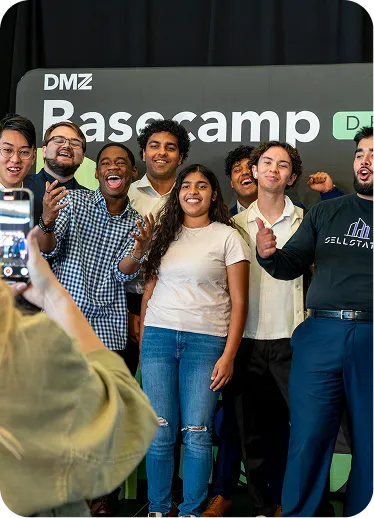On October 8, 2019, as part of Mental Health Illness Awareness Week, the DMZ , Inkblot Therapy and the Ryerson Career & Co-Op Centre proudly partnered to organize a half-day event called Investing in Inclusion: Burnout and Work-Life Balance.
At the event, attendees heard honest and engaging firsthand accounts of burnout and workplace stress from keynote panelists:
- Julie Sabine (Moderator), CMO, Inkblot Technologies
- Cherry Rose Tan, Founder & CEO, For Founders by Founders
- Hamza Khan, Managing Director, Student Life Network
- Jason Tafler, CEO & Founder, Unyte
- Sara Asalya, Graduate Student, OISE & Ryerson Employee
Why talk about burnout and workplace stress? Well, according to findings from Statistics Canada, 20% of Canadians will experience burnout at some point in their life. In addition, almost 40% of Canadians suffer from workplace stress, attributed most commonly to inflexible schedules, long hours, constant connectivity, tight deadlines and a lack of vacation time. By talking openly and bravely about their personal experiences, the panelists shone a light on these statistics and raised three important lessons:
1. Burnout can happen to anyone, at anytime
Although we often associate burnout with life in the high-pressure corporations, it's prevalent across all industries and places of work - from the corporate world, to the public sector, to the startup ecosystem.
The Centre for Addiction and Mental Health defines burnout as, "a state of emotional, physical and mental exhaustion caused by excessive and prolonged stress," and says symptoms of burnout can include:
- Feeling emotionally drained and unable to function at work or in other areas of life
- Experiencing physical symptoms like back aches, headaches, loss of appetite or disrupted sleep
- Becoming increasingly withdrawn and reclusive, and feeling disengaged
- Calling in sick to work more often, lacking motivation and having difficulties getting things done
- Experiencing a drop in confidence, feeling like a failure or having feelings of helplessness
Symptoms can affect individuals in different ways, and burnout often creeps up slowly - especially during busy times.
Jason Tafler shared that, for years, he relentlessly chased after success, worked hard, and checked off all the boxes he thought he should. Yet, the results of his achievements weren't good health and happiness. In fact, they were the quite opposite. One day, when he was sitting in a board meeting, he started to feel unwell. It was during a particularly stressful period at work where he was pushing himself to the limits. He looked down at his hands and saw, to his alarm, that they were turning yellow. He realized that something was seriously wrong and that he needed to get to a hospital immediately.
Jason recounted, "At that meeting, I wasn't thinking about what I had achieved at work, or how much money I had in the bank. All I was thinking about was whether or not I'd make it to the hospital and, if I survived, how I needed to start focusing on what was really important to me." Jason learned at the hospital later that night that he was suffering from internal bleeding, stating, "I worked myself to the point where I literally almost bled to death."
Hamza Khan's experience with burnout was different, yet many of the underlying factors were similar. Hamza always considered himself a high performer and believed that achieving success meant pushing himself hard. "I didn't have a healthy relationship with work and I believed many unhealthy myths about success and productivity," he shared. He said social media only worsened the problem, where 'inspirational' quotes on his feed about productivity, achievement and happiness added to the stress he already felt.
As a result, Hamza started to burn out. He missed deadlines, his performance was lackluster and he started to suffer from long depressive episodes. He recounted experiencing an identity crisis at one point, where his expectations of himself weren't matching his performance at work. It wasn't until he realized that there was something very wrong that he started reaching out for help and making changes in his life.
Stories like these show that burnout can sneak up on any of us, at any time - even if we think we're immune or following the right path.
2. It's time for companies to talk openly about mental health
With one in five Canadians experiencing burnout at some point in their life and almost half of us suffering from workplace stress, it's time to make changes in the workplace to support mental health and wellness. But how can we do this?
Cherry Rose Tan spoke about her experiences with workplace stress and said, "In the startup community, it's time for founders to talk more openly about mental health and create safe spaces to share what they're going through personally or at work. Instead of talking to me about your IPO, talk to me about how you're feeling."
For Cherry Rose, a healthy work environment isn't about creating room for a ping pong table, it's about creating room for honest dialogue around the realities of mental health. After going through a series of traumatic events in her life, and wondering where she could turn to for support, she realized that she probably wasn't alone. Having brave conversations is a way we can support each other and mental health in the workplace.
Sara Asalya offered a similar viewpoint. After migrating to Canada, Sara landed a job that seemed good on paper. But she soon learned that the company cared more about sales quotas than about taking care of their employees. Despite mounting responsibilities at home and the stress of being in a new country, she pushed herself hard and kept going. "I felt so alone," she said. "I wanted to be successful at work and a perfect mom at home, and there were high expectations. I was scared to bring up anything at work because I feared they'd question whether or not I could handle the job."
When Sara reached her breaking point, she realized that she needed to unlearn what she had been taught about success, and instead take care of herself first. She also realized that her workplace had undermined her mental health due to its unhealthy power dynamics and micromanaging. "Most chronic workplace stress goes unnoticed. It's time we talk about that," said Sara.
3. New resources and communities are offering additional means of supporting mental health
There are many ways to support mental health - some conventional and some that are taking new approaches. Our panelists shared how they're contributing to developing new and promising means of supporting mental health:
- Inkblot is revolutionizing mental health care by offering confidential and convenient support - any time, any place. Inkblot's Employee Mental Health Services create more positive and engaging workplaces and are utilized by forward-thinking organizations including the DMZ, League, 500px, tucows and TribalScale. Julie Sabine is the CMO at Inkblot.
- For Founders by Founders is a mental health movement for the tech industry where founders and investors can pledge their mental health stories as survivors or allies. For Founders by Founders is based on the premise that change happens when we share our truth and have brave conversations. Cherry Rose is the Founder & CEO of For Founders by Founders.
- Unyte offers a self-regulation device and immersive meditation experiences that leads users to reach new levels of calm and wellness. Using real-time biofeedback, Unyte provides an evidence-based guide that fosters a healthy coping lifestyle. Jason Tafler is the CEO & Founder of Unyte.
- Fresponsibility is a word that means "a workplace culture that encourages self-managed co-workers to enjoy responsible freedom within a decentralized decision-making climate and minimum hierarchy." Fresponsibility is built around five pillars: autonomy, radical transparency, open communication, people first, and intrinsic motivation. Sara Asalya is working to advance the concept of fresponsibility.
Burnout and workplace stress can be experienced by anyone, at any time, and dialogue is an important step to calling out the factors that contribute to unhealthy situations.


.webp)




